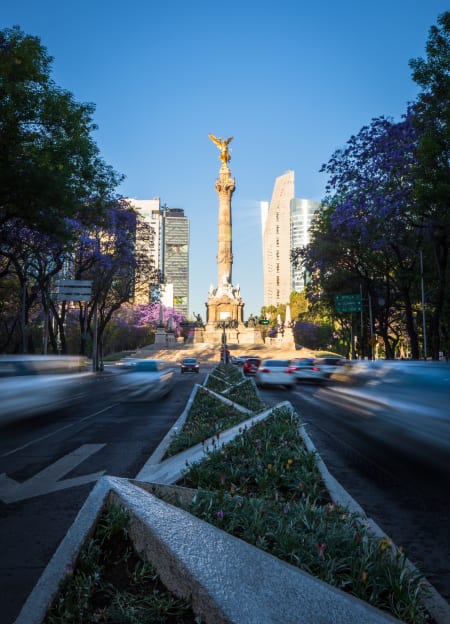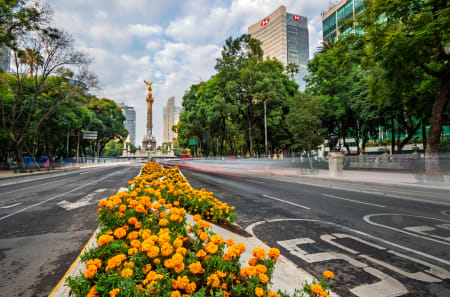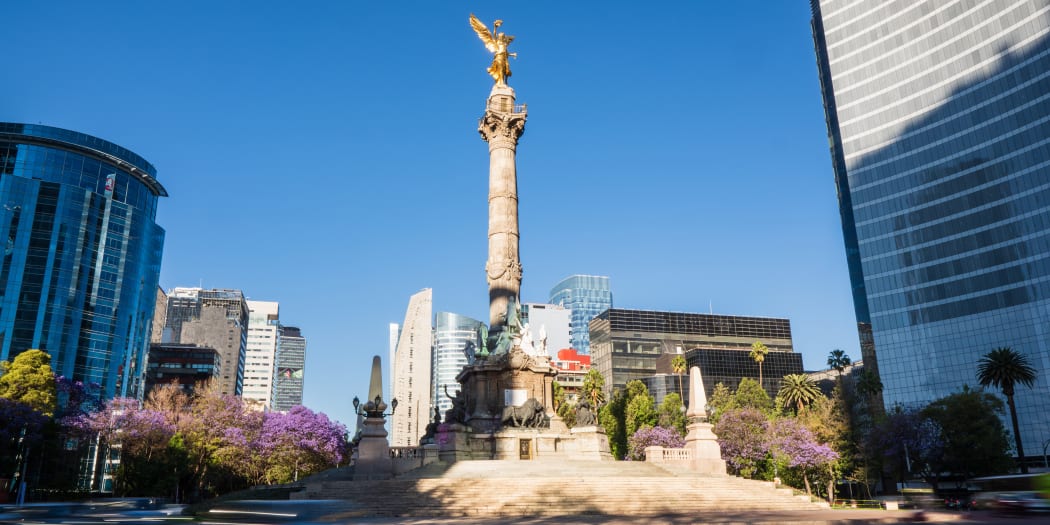Commemorating Mexican Independence
The Angel of Independence commemorates Mexico’s victory in the War of Independence from Spain. The monument’s inauguration on September 16, 1910 marked the 100th anniversary of El Grito de Dolores, when Miguel Hidalgo rang the bells of his church in Dolores, Hidalgo, summoning the people of his parish to arms in a moment widely considered to be the start of Mexico’s War of Independence.
Hidalgo’s remains are now laid to rest in a mausoleum inside the Angel of Independence, alongside thirteen other prominent insurgents.
The monument was commissioned by President Porfirio Diaz, envisaged as the centerpiece of a series of events to mark the centenary of Mexican Independence in 1910.
Diaz had ruled Mexico as a president-dictator for over three decades, and by 1910 his authoritarian rule was increasingly unpopular. Despite presiding over an economic boom as the Mexican economy opened up to foreign investment, this had failed to raise living standards for many, with widespread poverty, inequality and atrocious working conditions.
By the time the Angel of Independence was inaugurated in 1910, Diaz was in the final months of his presidency. The Mexican Revolution would begin later that year, removing Diaz from power and kicking off a decade-long series of conflicts that would unleash chaos, suffering and political turmoil but would ultimately bring Mexico into the modern era with a transformed government, society and constitution.
Following the revolution, the Angel of Independence became a focal point for the city. Political protests gather below El Ángel to march to the Palacio Nacional. Crowds take to the street below the monument to celebrate Mexico’s football victories.

Avenida Paseo de la Reforma
The Angel of Independence sits in the centre of Mexico City’s most famous boulevard, Avenida Paseo de la Reforma, the grand imperial vision of Emperor Maximilian I.
Maximilian ruled Mexico during France’s brief intervention in the 1860s, after Napoleon III invaded. Ostensibly the French intervention was caused by a dispute over unpaid debt, but a more likely motivation was a desire to match Britain as an imperial power and limit the expansion of the Protestant United States.
From his home in Chapultepec Castle, Maximilian envisioned a grand avenue similar the Champs-Élysées in Paris. The avenue would run from the entrance of Chapultepec Castle, through what was at the time undeveloped ranches and forest, into the heart of the Centro Histórico to reach the Palacio Nacional in the Zocalo.
Over the 19th and 20th centuries, as the city expanded to the west, Avenida Paseo de la Reforma has become the bustling heart of the city’s business and financial district.

Getting There
The Angel of Independence makes a great starting point for a walk along Avenida Paseo de la Reforma. Built in the 19th century in the style of the central avenues of Europe’s capitals, the avenue showcases some of Mexico City’s grandest architecture.
Starting at the Angel of Independence, join the crowds lining up to take photos of the bronze statue and take in the vista stretching down the avenue towards Chapultepec Castle.
Then, begin a 15-minute walk along the avenue, passing the Fountain of Diana the Huntress (Fuente de la Diana Cazadora). This dramatic statue of the Roman goddess was commissioned by the government in the 1930s, at the height of the Mexican muralist movement when the government was actively developing ambitious public works of art in city streets across Mexico.
Up next, more recent but equally ambitious architectural accomplishments can be seen. The skyscrapers that line the top section of the avenue, Torre Reforma, Chapultepec Uno, Torre BBVA and Torre Mayor all rank among the 10 tallest buildings in Mexico.
At the top of the avenue are the main entrance gates to Chapultepec Park. Here, you can take a stroll along forested pathways for a break from the city, or continue up the hill to visit the historic Chapultepec Castle. Several prestigious museums are just a short walk away, including the expansive National Museum of Anthropology.
The Angel of Independence can be safely reached on bicycle. There is a dedicated bike lane separated from the traffic which runs along Avenida Paseo de la Reforma.
To the west, this bike lane heads towards Chapultepec Park and the Polanco neighborhood. To the east, the bike lane continues to Palacio de Bellas Artes in the Centro Histórico.
Every Sunday morning, Avenida Paseo de la Reforma is closed to traffic, which makes this the perfect time to explore the area on bicycle.
Bikes can be hired by the minute using the Ecobici app, with hundreds of stations located on almost every major street corner in this region of Mexico City. Download the app, find an Ecobici station, and unlock any bike by scanning the QR code printed on each bike.
Rideshare apps Uber and Didi are widely used across Mexico City.
Select as your destination:
- Angel of Independence
- Paseo de la Reforma, Colonia Cuauhtémoc, Cuauhtémoc, 06500, Mexico City
The center of Mexico City is clogged with traffic and difficult for visitors to navigate when driving. But for those choosing to self-drive, there are several parking lots close to the Angel of Independence.
Options include:
On-street parking is also available on the surrounding streets. Make sure to check the hours printed on the on-street parking meters and purchase a ticket, to avoid having your vehicle clamped.
Turibus is a convenient way to tour all of Mexico City’s major sights in a short time. Open-top buses offer great views of the city, while the driver takes care of navigating the chaotic streets.
The Turibus Centro Historico route stops by the Angel of Independence. This circuit also covers many of the city’s major points of interest, including:
- The Zócalo & Metropolitan Cathedral
- National Museum of Anthropology
- Palacio de Bellas Artes
- Monument to the Revolution
Full details of the route and pick-up points are available from Turibus.
Tickets can be purchased in-person at the bus stops, or prebook online from Turibus, Viator or Get Your Guide
The Angel of Independence is easily accessed via Line 7 of the Metrobus network, which runs along Avenida Paseo de la Reforma.
The nearest station is El Ángel. Line 7 links Avenida Paseo de la Reforma to Chapultepec Park and Polanco to the west, and the Centro Historico to the east.
The monument is also a short walk away from the station Hamburgo on Line 1. This line runs down Avenida Insurgentes Sur, with a number stations allowing convenient access to Roma and Condesa (including Durango, Álvaro Obregón and Chilpancingo).
Due to the closure of Line 1 for major renovations, the Metrobus offers easier connections to the city’s other major touristic centers, including the Centro Historico, Roma, Condesa and Juárez.

